Mediterranean Delights (MDL) Financial Analysis and Budgeting Report
VerifiedAdded on 2023/01/12
|11
|3296
|66
Report
AI Summary
This report provides a comprehensive financial analysis of Mediterranean Delights (MDL), a trading company supplying products to various users, focusing on working capital management and its impact on cash flows. Part 1 explains key financial terms like profit, cash flow, working capital components (inventory, receivables, payables), and how changes in working capital affect cash flow. It examines MDL's management's influence on financial results, highlighting issues such as increased debt, blocked funds, and outstanding receivables. The report suggests steps MDL can take to improve cash flows through effective working capital management, including refining receivables policies. Part 2 discusses the purpose of budgeting, comparing traditional and alternative budgeting approaches (rolling and activity-based budgeting) and their strengths and weaknesses. The analysis emphasizes the importance of budgeting for resource allocation, performance monitoring, and cost control, providing valuable insights into MDL's financial strategies.

Paraphrase This Document
Need a fresh take? Get an instant paraphrase of this document with our AI Paraphraser
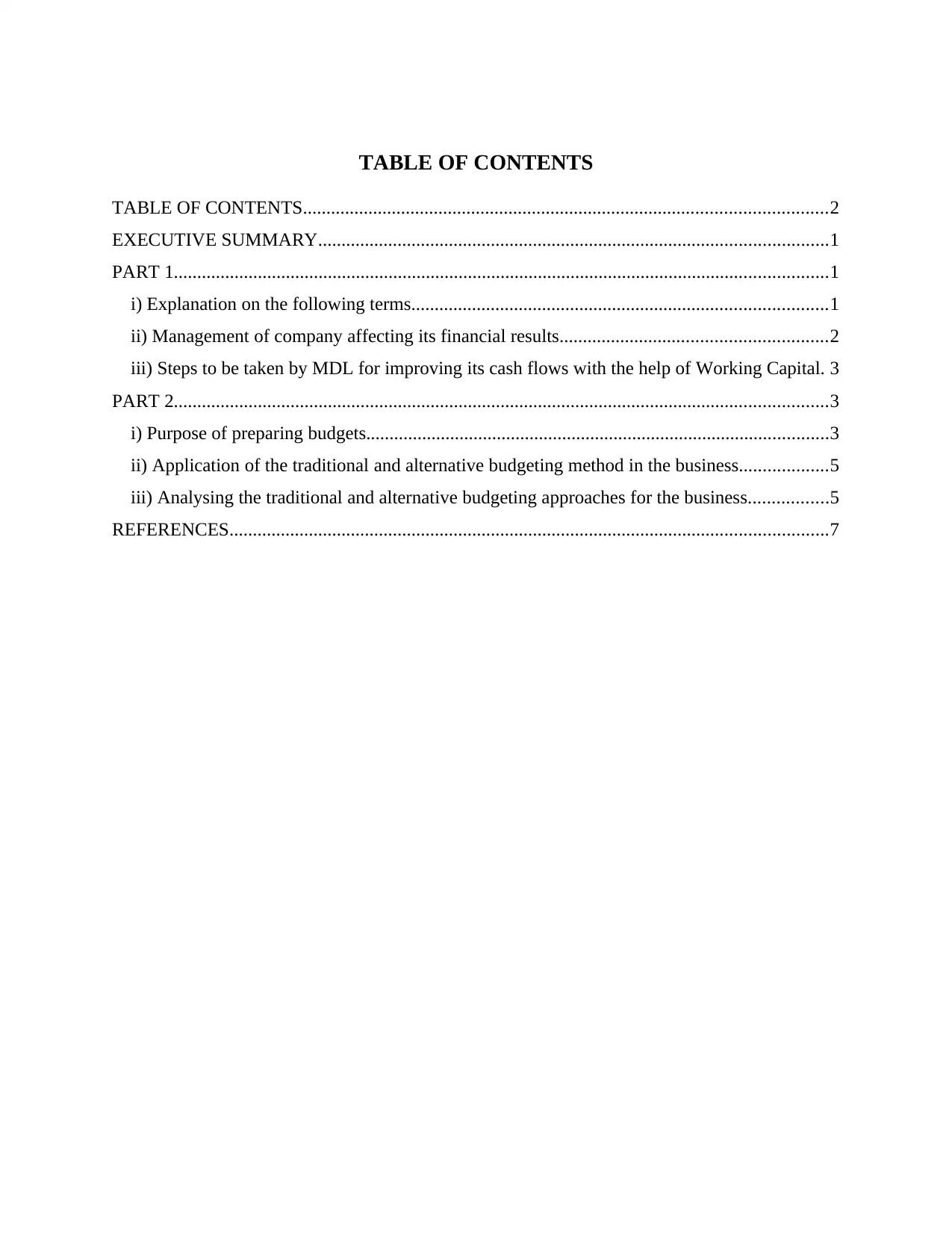
TABLE OF CONTENTS
TABLE OF CONTENTS................................................................................................................2
EXECUTIVE SUMMARY.............................................................................................................1
PART 1............................................................................................................................................1
i) Explanation on the following terms.........................................................................................1
ii) Management of company affecting its financial results.........................................................2
iii) Steps to be taken by MDL for improving its cash flows with the help of Working Capital. 3
PART 2............................................................................................................................................3
i) Purpose of preparing budgets...................................................................................................3
ii) Application of the traditional and alternative budgeting method in the business...................5
iii) Analysing the traditional and alternative budgeting approaches for the business.................5
REFERENCES................................................................................................................................7
TABLE OF CONTENTS................................................................................................................2
EXECUTIVE SUMMARY.............................................................................................................1
PART 1............................................................................................................................................1
i) Explanation on the following terms.........................................................................................1
ii) Management of company affecting its financial results.........................................................2
iii) Steps to be taken by MDL for improving its cash flows with the help of Working Capital. 3
PART 2............................................................................................................................................3
i) Purpose of preparing budgets...................................................................................................3
ii) Application of the traditional and alternative budgeting method in the business...................5
iii) Analysing the traditional and alternative budgeting approaches for the business.................5
REFERENCES................................................................................................................................7
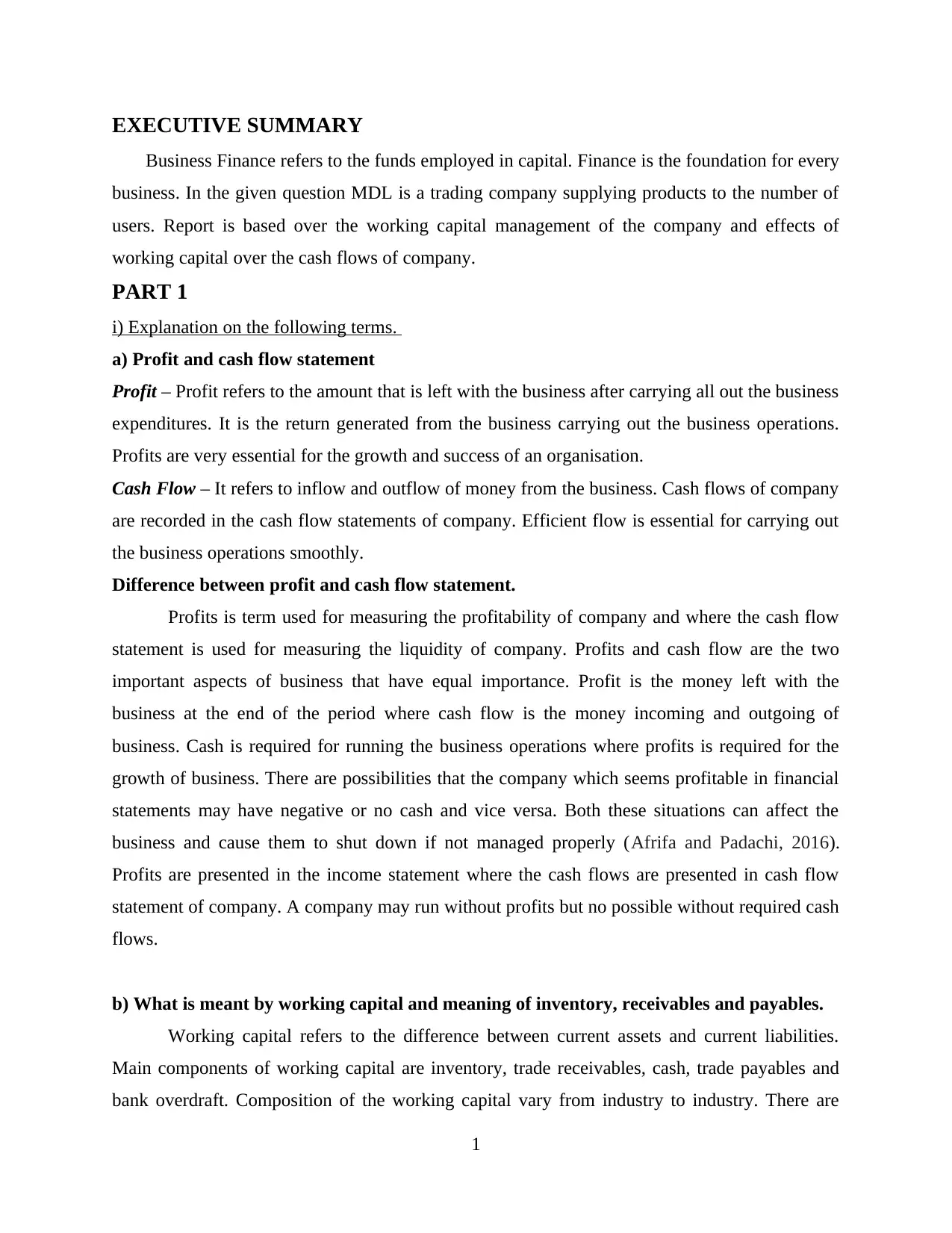
EXECUTIVE SUMMARY
Business Finance refers to the funds employed in capital. Finance is the foundation for every
business. In the given question MDL is a trading company supplying products to the number of
users. Report is based over the working capital management of the company and effects of
working capital over the cash flows of company.
PART 1
i) Explanation on the following terms.
a) Profit and cash flow statement
Profit – Profit refers to the amount that is left with the business after carrying all out the business
expenditures. It is the return generated from the business carrying out the business operations.
Profits are very essential for the growth and success of an organisation.
Cash Flow – It refers to inflow and outflow of money from the business. Cash flows of company
are recorded in the cash flow statements of company. Efficient flow is essential for carrying out
the business operations smoothly.
Difference between profit and cash flow statement.
Profits is term used for measuring the profitability of company and where the cash flow
statement is used for measuring the liquidity of company. Profits and cash flow are the two
important aspects of business that have equal importance. Profit is the money left with the
business at the end of the period where cash flow is the money incoming and outgoing of
business. Cash is required for running the business operations where profits is required for the
growth of business. There are possibilities that the company which seems profitable in financial
statements may have negative or no cash and vice versa. Both these situations can affect the
business and cause them to shut down if not managed properly (Afrifa and Padachi, 2016).
Profits are presented in the income statement where the cash flows are presented in cash flow
statement of company. A company may run without profits but no possible without required cash
flows.
b) What is meant by working capital and meaning of inventory, receivables and payables.
Working capital refers to the difference between current assets and current liabilities.
Main components of working capital are inventory, trade receivables, cash, trade payables and
bank overdraft. Composition of the working capital vary from industry to industry. There are
1
Business Finance refers to the funds employed in capital. Finance is the foundation for every
business. In the given question MDL is a trading company supplying products to the number of
users. Report is based over the working capital management of the company and effects of
working capital over the cash flows of company.
PART 1
i) Explanation on the following terms.
a) Profit and cash flow statement
Profit – Profit refers to the amount that is left with the business after carrying all out the business
expenditures. It is the return generated from the business carrying out the business operations.
Profits are very essential for the growth and success of an organisation.
Cash Flow – It refers to inflow and outflow of money from the business. Cash flows of company
are recorded in the cash flow statements of company. Efficient flow is essential for carrying out
the business operations smoothly.
Difference between profit and cash flow statement.
Profits is term used for measuring the profitability of company and where the cash flow
statement is used for measuring the liquidity of company. Profits and cash flow are the two
important aspects of business that have equal importance. Profit is the money left with the
business at the end of the period where cash flow is the money incoming and outgoing of
business. Cash is required for running the business operations where profits is required for the
growth of business. There are possibilities that the company which seems profitable in financial
statements may have negative or no cash and vice versa. Both these situations can affect the
business and cause them to shut down if not managed properly (Afrifa and Padachi, 2016).
Profits are presented in the income statement where the cash flows are presented in cash flow
statement of company. A company may run without profits but no possible without required cash
flows.
b) What is meant by working capital and meaning of inventory, receivables and payables.
Working capital refers to the difference between current assets and current liabilities.
Main components of working capital are inventory, trade receivables, cash, trade payables and
bank overdraft. Composition of the working capital vary from industry to industry. There are
1
⊘ This is a preview!⊘
Do you want full access?
Subscribe today to unlock all pages.

Trusted by 1+ million students worldwide
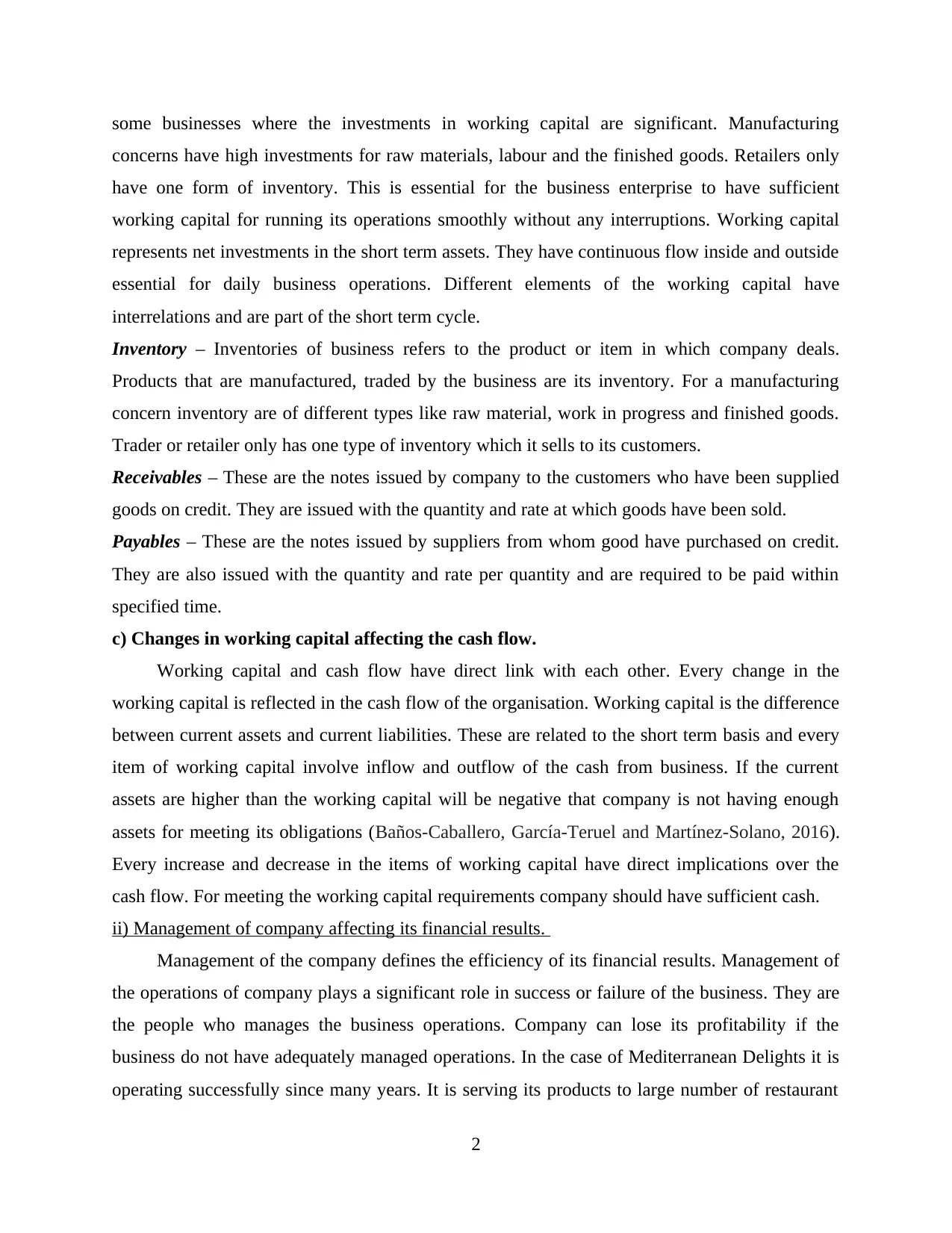
some businesses where the investments in working capital are significant. Manufacturing
concerns have high investments for raw materials, labour and the finished goods. Retailers only
have one form of inventory. This is essential for the business enterprise to have sufficient
working capital for running its operations smoothly without any interruptions. Working capital
represents net investments in the short term assets. They have continuous flow inside and outside
essential for daily business operations. Different elements of the working capital have
interrelations and are part of the short term cycle.
Inventory – Inventories of business refers to the product or item in which company deals.
Products that are manufactured, traded by the business are its inventory. For a manufacturing
concern inventory are of different types like raw material, work in progress and finished goods.
Trader or retailer only has one type of inventory which it sells to its customers.
Receivables – These are the notes issued by company to the customers who have been supplied
goods on credit. They are issued with the quantity and rate at which goods have been sold.
Payables – These are the notes issued by suppliers from whom good have purchased on credit.
They are also issued with the quantity and rate per quantity and are required to be paid within
specified time.
c) Changes in working capital affecting the cash flow.
Working capital and cash flow have direct link with each other. Every change in the
working capital is reflected in the cash flow of the organisation. Working capital is the difference
between current assets and current liabilities. These are related to the short term basis and every
item of working capital involve inflow and outflow of the cash from business. If the current
assets are higher than the working capital will be negative that company is not having enough
assets for meeting its obligations (Baños-Caballero, García-Teruel and Martínez-Solano, 2016).
Every increase and decrease in the items of working capital have direct implications over the
cash flow. For meeting the working capital requirements company should have sufficient cash.
ii) Management of company affecting its financial results.
Management of the company defines the efficiency of its financial results. Management of
the operations of company plays a significant role in success or failure of the business. They are
the people who manages the business operations. Company can lose its profitability if the
business do not have adequately managed operations. In the case of Mediterranean Delights it is
operating successfully since many years. It is serving its products to large number of restaurant
2
concerns have high investments for raw materials, labour and the finished goods. Retailers only
have one form of inventory. This is essential for the business enterprise to have sufficient
working capital for running its operations smoothly without any interruptions. Working capital
represents net investments in the short term assets. They have continuous flow inside and outside
essential for daily business operations. Different elements of the working capital have
interrelations and are part of the short term cycle.
Inventory – Inventories of business refers to the product or item in which company deals.
Products that are manufactured, traded by the business are its inventory. For a manufacturing
concern inventory are of different types like raw material, work in progress and finished goods.
Trader or retailer only has one type of inventory which it sells to its customers.
Receivables – These are the notes issued by company to the customers who have been supplied
goods on credit. They are issued with the quantity and rate at which goods have been sold.
Payables – These are the notes issued by suppliers from whom good have purchased on credit.
They are also issued with the quantity and rate per quantity and are required to be paid within
specified time.
c) Changes in working capital affecting the cash flow.
Working capital and cash flow have direct link with each other. Every change in the
working capital is reflected in the cash flow of the organisation. Working capital is the difference
between current assets and current liabilities. These are related to the short term basis and every
item of working capital involve inflow and outflow of the cash from business. If the current
assets are higher than the working capital will be negative that company is not having enough
assets for meeting its obligations (Baños-Caballero, García-Teruel and Martínez-Solano, 2016).
Every increase and decrease in the items of working capital have direct implications over the
cash flow. For meeting the working capital requirements company should have sufficient cash.
ii) Management of company affecting its financial results.
Management of the company defines the efficiency of its financial results. Management of
the operations of company plays a significant role in success or failure of the business. They are
the people who manages the business operations. Company can lose its profitability if the
business do not have adequately managed operations. In the case of Mediterranean Delights it is
operating successfully since many years. It is serving its products to large number of restaurant
2
Paraphrase This Document
Need a fresh take? Get an instant paraphrase of this document with our AI Paraphraser
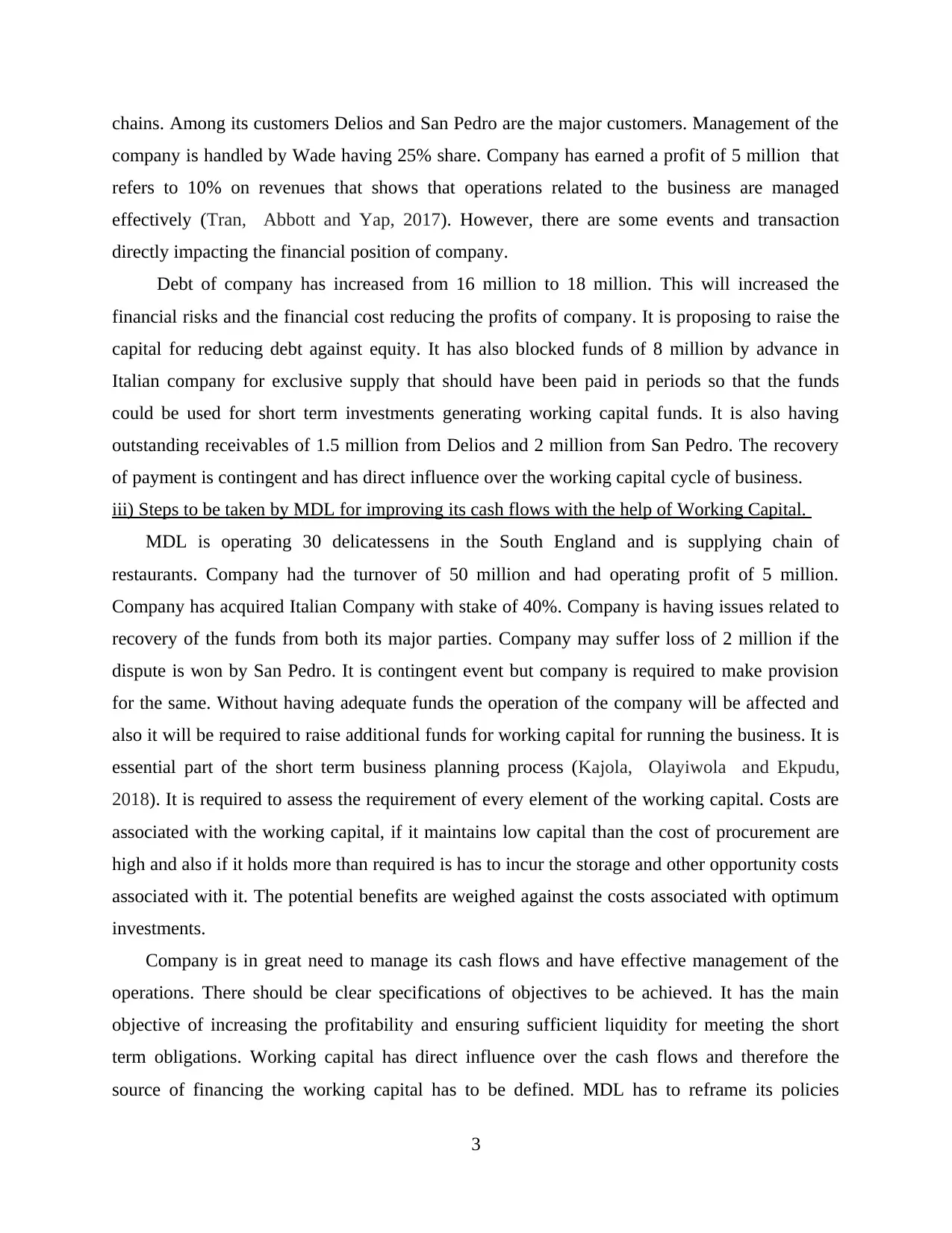
chains. Among its customers Delios and San Pedro are the major customers. Management of the
company is handled by Wade having 25% share. Company has earned a profit of 5 million that
refers to 10% on revenues that shows that operations related to the business are managed
effectively (Tran, Abbott and Yap, 2017). However, there are some events and transaction
directly impacting the financial position of company.
Debt of company has increased from 16 million to 18 million. This will increased the
financial risks and the financial cost reducing the profits of company. It is proposing to raise the
capital for reducing debt against equity. It has also blocked funds of 8 million by advance in
Italian company for exclusive supply that should have been paid in periods so that the funds
could be used for short term investments generating working capital funds. It is also having
outstanding receivables of 1.5 million from Delios and 2 million from San Pedro. The recovery
of payment is contingent and has direct influence over the working capital cycle of business.
iii) Steps to be taken by MDL for improving its cash flows with the help of Working Capital.
MDL is operating 30 delicatessens in the South England and is supplying chain of
restaurants. Company had the turnover of 50 million and had operating profit of 5 million.
Company has acquired Italian Company with stake of 40%. Company is having issues related to
recovery of the funds from both its major parties. Company may suffer loss of 2 million if the
dispute is won by San Pedro. It is contingent event but company is required to make provision
for the same. Without having adequate funds the operation of the company will be affected and
also it will be required to raise additional funds for working capital for running the business. It is
essential part of the short term business planning process (Kajola, Olayiwola and Ekpudu,
2018). It is required to assess the requirement of every element of the working capital. Costs are
associated with the working capital, if it maintains low capital than the cost of procurement are
high and also if it holds more than required is has to incur the storage and other opportunity costs
associated with it. The potential benefits are weighed against the costs associated with optimum
investments.
Company is in great need to manage its cash flows and have effective management of the
operations. There should be clear specifications of objectives to be achieved. It has the main
objective of increasing the profitability and ensuring sufficient liquidity for meeting the short
term obligations. Working capital has direct influence over the cash flows and therefore the
source of financing the working capital has to be defined. MDL has to reframe its policies
3
company is handled by Wade having 25% share. Company has earned a profit of 5 million that
refers to 10% on revenues that shows that operations related to the business are managed
effectively (Tran, Abbott and Yap, 2017). However, there are some events and transaction
directly impacting the financial position of company.
Debt of company has increased from 16 million to 18 million. This will increased the
financial risks and the financial cost reducing the profits of company. It is proposing to raise the
capital for reducing debt against equity. It has also blocked funds of 8 million by advance in
Italian company for exclusive supply that should have been paid in periods so that the funds
could be used for short term investments generating working capital funds. It is also having
outstanding receivables of 1.5 million from Delios and 2 million from San Pedro. The recovery
of payment is contingent and has direct influence over the working capital cycle of business.
iii) Steps to be taken by MDL for improving its cash flows with the help of Working Capital.
MDL is operating 30 delicatessens in the South England and is supplying chain of
restaurants. Company had the turnover of 50 million and had operating profit of 5 million.
Company has acquired Italian Company with stake of 40%. Company is having issues related to
recovery of the funds from both its major parties. Company may suffer loss of 2 million if the
dispute is won by San Pedro. It is contingent event but company is required to make provision
for the same. Without having adequate funds the operation of the company will be affected and
also it will be required to raise additional funds for working capital for running the business. It is
essential part of the short term business planning process (Kajola, Olayiwola and Ekpudu,
2018). It is required to assess the requirement of every element of the working capital. Costs are
associated with the working capital, if it maintains low capital than the cost of procurement are
high and also if it holds more than required is has to incur the storage and other opportunity costs
associated with it. The potential benefits are weighed against the costs associated with optimum
investments.
Company is in great need to manage its cash flows and have effective management of the
operations. There should be clear specifications of objectives to be achieved. It has the main
objective of increasing the profitability and ensuring sufficient liquidity for meeting the short
term obligations. Working capital has direct influence over the cash flows and therefore the
source of financing the working capital has to be defined. MDL has to reframe its policies
3
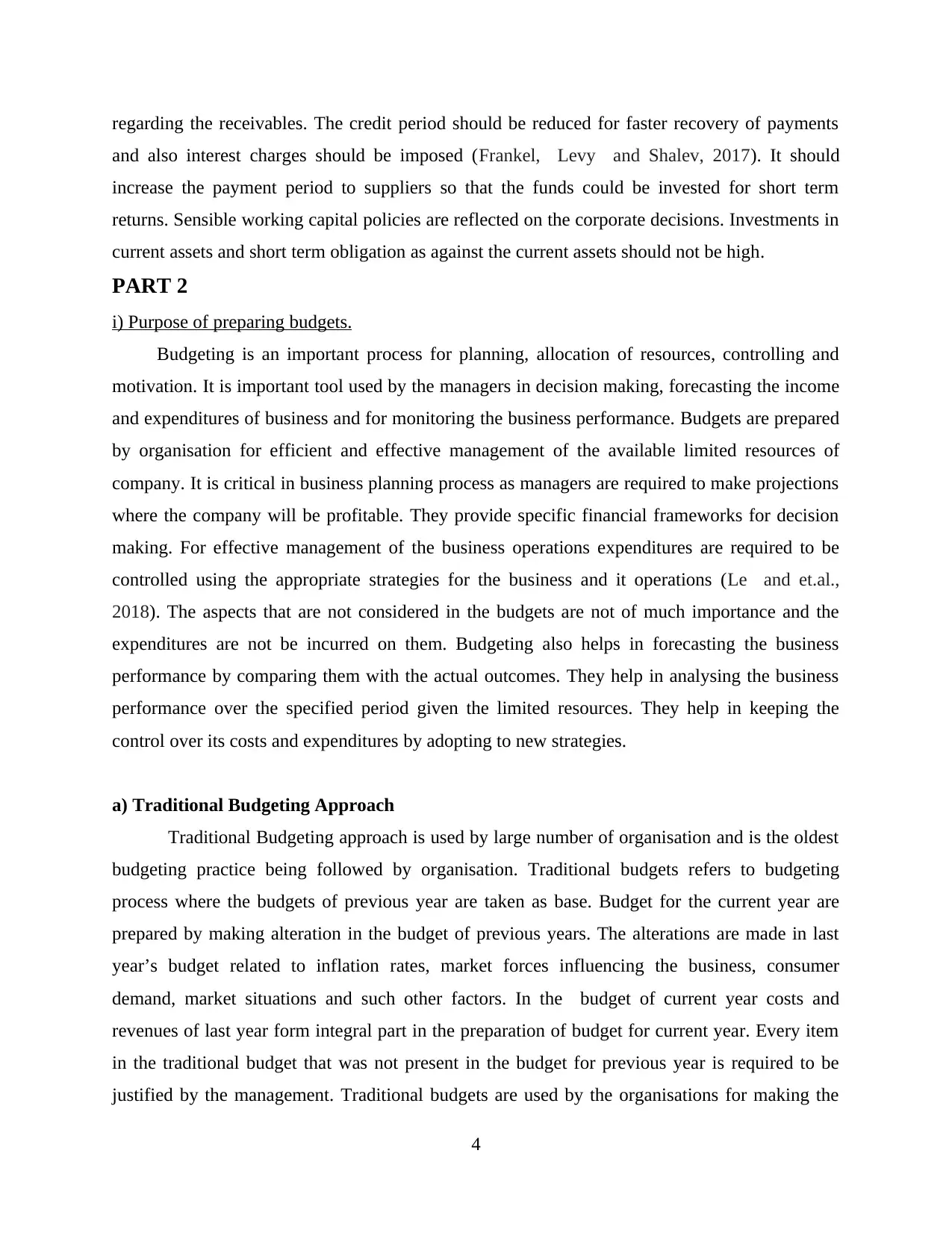
regarding the receivables. The credit period should be reduced for faster recovery of payments
and also interest charges should be imposed (Frankel, Levy and Shalev, 2017). It should
increase the payment period to suppliers so that the funds could be invested for short term
returns. Sensible working capital policies are reflected on the corporate decisions. Investments in
current assets and short term obligation as against the current assets should not be high.
PART 2
i) Purpose of preparing budgets.
Budgeting is an important process for planning, allocation of resources, controlling and
motivation. It is important tool used by the managers in decision making, forecasting the income
and expenditures of business and for monitoring the business performance. Budgets are prepared
by organisation for efficient and effective management of the available limited resources of
company. It is critical in business planning process as managers are required to make projections
where the company will be profitable. They provide specific financial frameworks for decision
making. For effective management of the business operations expenditures are required to be
controlled using the appropriate strategies for the business and it operations (Le and et.al.,
2018). The aspects that are not considered in the budgets are not of much importance and the
expenditures are not be incurred on them. Budgeting also helps in forecasting the business
performance by comparing them with the actual outcomes. They help in analysing the business
performance over the specified period given the limited resources. They help in keeping the
control over its costs and expenditures by adopting to new strategies.
a) Traditional Budgeting Approach
Traditional Budgeting approach is used by large number of organisation and is the oldest
budgeting practice being followed by organisation. Traditional budgets refers to budgeting
process where the budgets of previous year are taken as base. Budget for the current year are
prepared by making alteration in the budget of previous years. The alterations are made in last
year’s budget related to inflation rates, market forces influencing the business, consumer
demand, market situations and such other factors. In the budget of current year costs and
revenues of last year form integral part in the preparation of budget for current year. Every item
in the traditional budget that was not present in the budget for previous year is required to be
justified by the management. Traditional budgets are used by the organisations for making the
4
and also interest charges should be imposed (Frankel, Levy and Shalev, 2017). It should
increase the payment period to suppliers so that the funds could be invested for short term
returns. Sensible working capital policies are reflected on the corporate decisions. Investments in
current assets and short term obligation as against the current assets should not be high.
PART 2
i) Purpose of preparing budgets.
Budgeting is an important process for planning, allocation of resources, controlling and
motivation. It is important tool used by the managers in decision making, forecasting the income
and expenditures of business and for monitoring the business performance. Budgets are prepared
by organisation for efficient and effective management of the available limited resources of
company. It is critical in business planning process as managers are required to make projections
where the company will be profitable. They provide specific financial frameworks for decision
making. For effective management of the business operations expenditures are required to be
controlled using the appropriate strategies for the business and it operations (Le and et.al.,
2018). The aspects that are not considered in the budgets are not of much importance and the
expenditures are not be incurred on them. Budgeting also helps in forecasting the business
performance by comparing them with the actual outcomes. They help in analysing the business
performance over the specified period given the limited resources. They help in keeping the
control over its costs and expenditures by adopting to new strategies.
a) Traditional Budgeting Approach
Traditional Budgeting approach is used by large number of organisation and is the oldest
budgeting practice being followed by organisation. Traditional budgets refers to budgeting
process where the budgets of previous year are taken as base. Budget for the current year are
prepared by making alteration in the budget of previous years. The alterations are made in last
year’s budget related to inflation rates, market forces influencing the business, consumer
demand, market situations and such other factors. In the budget of current year costs and
revenues of last year form integral part in the preparation of budget for current year. Every item
in the traditional budget that was not present in the budget for previous year is required to be
justified by the management. Traditional budgets are used by the organisations for making the
4
⊘ This is a preview!⊘
Do you want full access?
Subscribe today to unlock all pages.

Trusted by 1+ million students worldwide
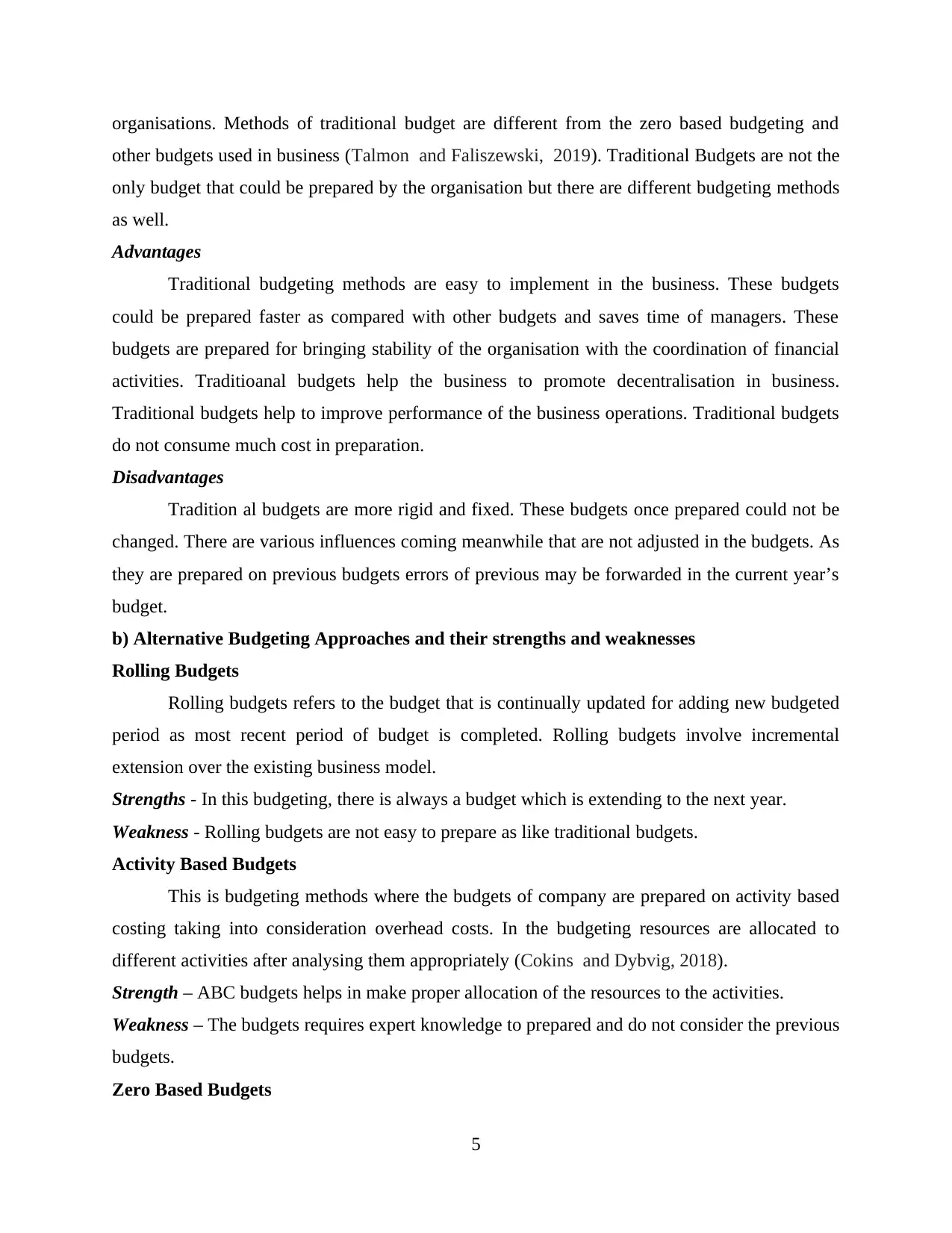
organisations. Methods of traditional budget are different from the zero based budgeting and
other budgets used in business (Talmon and Faliszewski, 2019). Traditional Budgets are not the
only budget that could be prepared by the organisation but there are different budgeting methods
as well.
Advantages
Traditional budgeting methods are easy to implement in the business. These budgets
could be prepared faster as compared with other budgets and saves time of managers. These
budgets are prepared for bringing stability of the organisation with the coordination of financial
activities. Traditioanal budgets help the business to promote decentralisation in business.
Traditional budgets help to improve performance of the business operations. Traditional budgets
do not consume much cost in preparation.
Disadvantages
Tradition al budgets are more rigid and fixed. These budgets once prepared could not be
changed. There are various influences coming meanwhile that are not adjusted in the budgets. As
they are prepared on previous budgets errors of previous may be forwarded in the current year’s
budget.
b) Alternative Budgeting Approaches and their strengths and weaknesses
Rolling Budgets
Rolling budgets refers to the budget that is continually updated for adding new budgeted
period as most recent period of budget is completed. Rolling budgets involve incremental
extension over the existing business model.
Strengths - In this budgeting, there is always a budget which is extending to the next year.
Weakness - Rolling budgets are not easy to prepare as like traditional budgets.
Activity Based Budgets
This is budgeting methods where the budgets of company are prepared on activity based
costing taking into consideration overhead costs. In the budgeting resources are allocated to
different activities after analysing them appropriately (Cokins and Dybvig, 2018).
Strength – ABC budgets helps in make proper allocation of the resources to the activities.
Weakness – The budgets requires expert knowledge to prepared and do not consider the previous
budgets.
Zero Based Budgets
5
other budgets used in business (Talmon and Faliszewski, 2019). Traditional Budgets are not the
only budget that could be prepared by the organisation but there are different budgeting methods
as well.
Advantages
Traditional budgeting methods are easy to implement in the business. These budgets
could be prepared faster as compared with other budgets and saves time of managers. These
budgets are prepared for bringing stability of the organisation with the coordination of financial
activities. Traditioanal budgets help the business to promote decentralisation in business.
Traditional budgets help to improve performance of the business operations. Traditional budgets
do not consume much cost in preparation.
Disadvantages
Tradition al budgets are more rigid and fixed. These budgets once prepared could not be
changed. There are various influences coming meanwhile that are not adjusted in the budgets. As
they are prepared on previous budgets errors of previous may be forwarded in the current year’s
budget.
b) Alternative Budgeting Approaches and their strengths and weaknesses
Rolling Budgets
Rolling budgets refers to the budget that is continually updated for adding new budgeted
period as most recent period of budget is completed. Rolling budgets involve incremental
extension over the existing business model.
Strengths - In this budgeting, there is always a budget which is extending to the next year.
Weakness - Rolling budgets are not easy to prepare as like traditional budgets.
Activity Based Budgets
This is budgeting methods where the budgets of company are prepared on activity based
costing taking into consideration overhead costs. In the budgeting resources are allocated to
different activities after analysing them appropriately (Cokins and Dybvig, 2018).
Strength – ABC budgets helps in make proper allocation of the resources to the activities.
Weakness – The budgets requires expert knowledge to prepared and do not consider the previous
budgets.
Zero Based Budgets
5
Paraphrase This Document
Need a fresh take? Get an instant paraphrase of this document with our AI Paraphraser
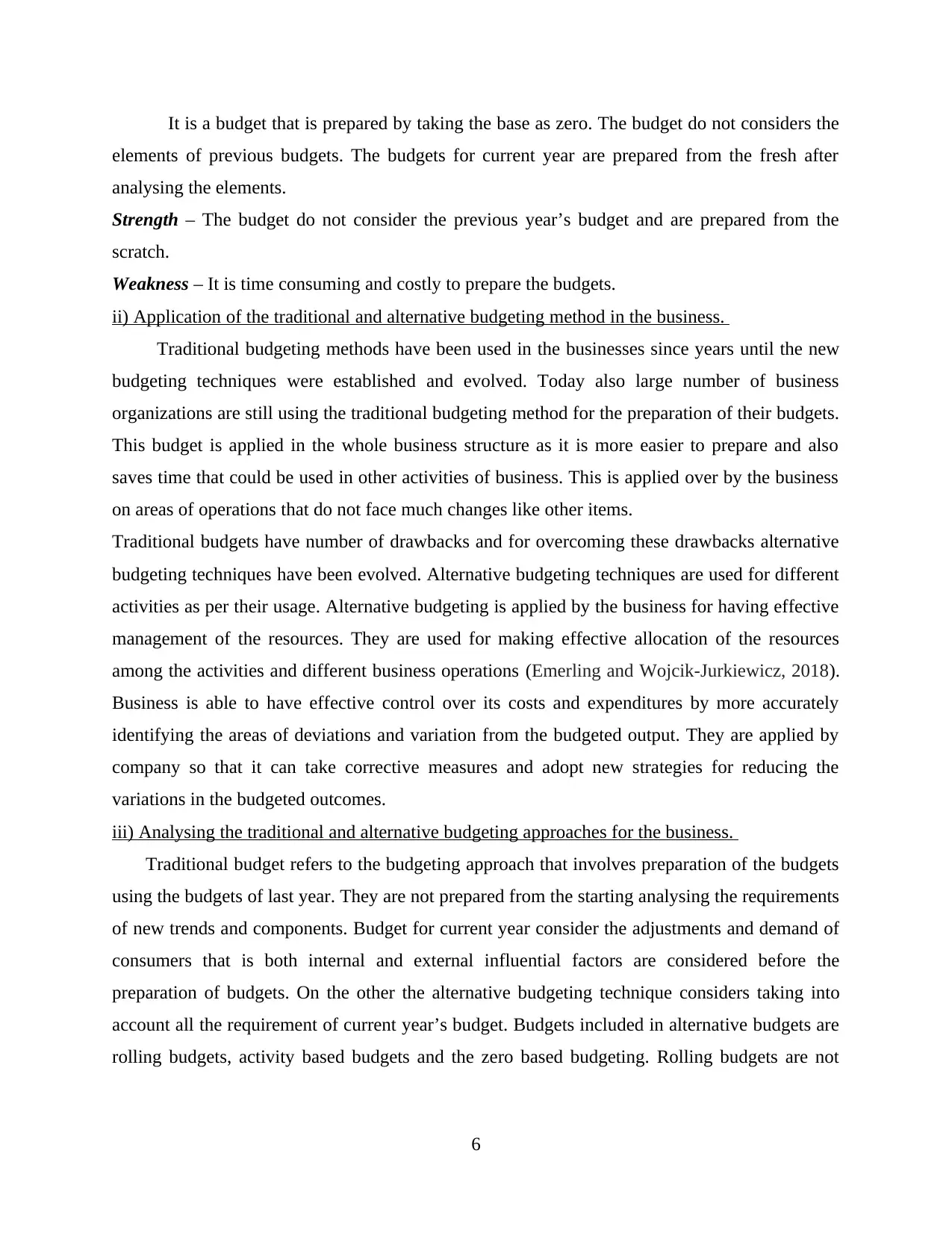
It is a budget that is prepared by taking the base as zero. The budget do not considers the
elements of previous budgets. The budgets for current year are prepared from the fresh after
analysing the elements.
Strength – The budget do not consider the previous year’s budget and are prepared from the
scratch.
Weakness – It is time consuming and costly to prepare the budgets.
ii) Application of the traditional and alternative budgeting method in the business.
Traditional budgeting methods have been used in the businesses since years until the new
budgeting techniques were established and evolved. Today also large number of business
organizations are still using the traditional budgeting method for the preparation of their budgets.
This budget is applied in the whole business structure as it is more easier to prepare and also
saves time that could be used in other activities of business. This is applied over by the business
on areas of operations that do not face much changes like other items.
Traditional budgets have number of drawbacks and for overcoming these drawbacks alternative
budgeting techniques have been evolved. Alternative budgeting techniques are used for different
activities as per their usage. Alternative budgeting is applied by the business for having effective
management of the resources. They are used for making effective allocation of the resources
among the activities and different business operations (Emerling and Wojcik-Jurkiewicz, 2018).
Business is able to have effective control over its costs and expenditures by more accurately
identifying the areas of deviations and variation from the budgeted output. They are applied by
company so that it can take corrective measures and adopt new strategies for reducing the
variations in the budgeted outcomes.
iii) Analysing the traditional and alternative budgeting approaches for the business.
Traditional budget refers to the budgeting approach that involves preparation of the budgets
using the budgets of last year. They are not prepared from the starting analysing the requirements
of new trends and components. Budget for current year consider the adjustments and demand of
consumers that is both internal and external influential factors are considered before the
preparation of budgets. On the other the alternative budgeting technique considers taking into
account all the requirement of current year’s budget. Budgets included in alternative budgets are
rolling budgets, activity based budgets and the zero based budgeting. Rolling budgets are not
6
elements of previous budgets. The budgets for current year are prepared from the fresh after
analysing the elements.
Strength – The budget do not consider the previous year’s budget and are prepared from the
scratch.
Weakness – It is time consuming and costly to prepare the budgets.
ii) Application of the traditional and alternative budgeting method in the business.
Traditional budgeting methods have been used in the businesses since years until the new
budgeting techniques were established and evolved. Today also large number of business
organizations are still using the traditional budgeting method for the preparation of their budgets.
This budget is applied in the whole business structure as it is more easier to prepare and also
saves time that could be used in other activities of business. This is applied over by the business
on areas of operations that do not face much changes like other items.
Traditional budgets have number of drawbacks and for overcoming these drawbacks alternative
budgeting techniques have been evolved. Alternative budgeting techniques are used for different
activities as per their usage. Alternative budgeting is applied by the business for having effective
management of the resources. They are used for making effective allocation of the resources
among the activities and different business operations (Emerling and Wojcik-Jurkiewicz, 2018).
Business is able to have effective control over its costs and expenditures by more accurately
identifying the areas of deviations and variation from the budgeted output. They are applied by
company so that it can take corrective measures and adopt new strategies for reducing the
variations in the budgeted outcomes.
iii) Analysing the traditional and alternative budgeting approaches for the business.
Traditional budget refers to the budgeting approach that involves preparation of the budgets
using the budgets of last year. They are not prepared from the starting analysing the requirements
of new trends and components. Budget for current year consider the adjustments and demand of
consumers that is both internal and external influential factors are considered before the
preparation of budgets. On the other the alternative budgeting technique considers taking into
account all the requirement of current year’s budget. Budgets included in alternative budgets are
rolling budgets, activity based budgets and the zero based budgeting. Rolling budgets are not
6
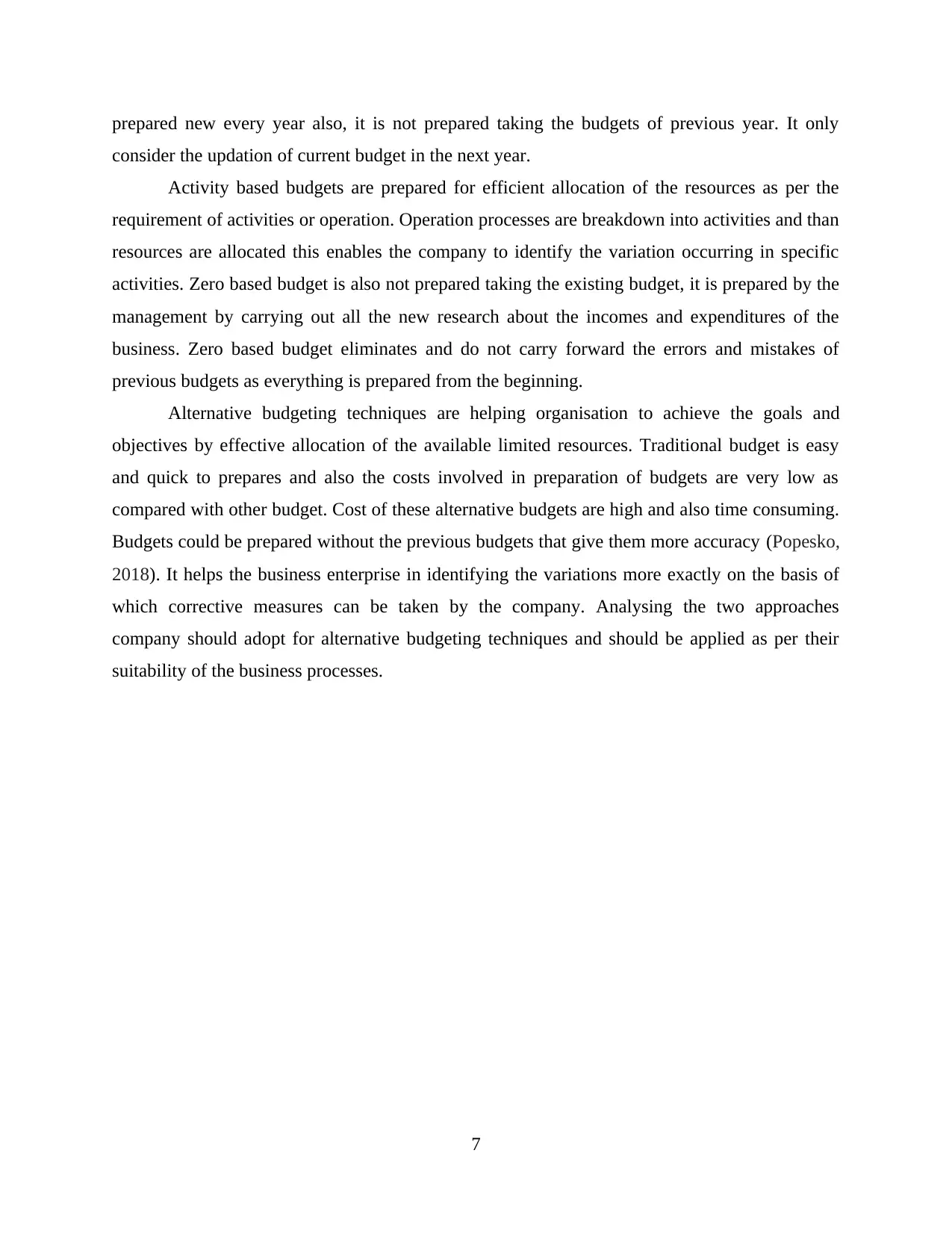
prepared new every year also, it is not prepared taking the budgets of previous year. It only
consider the updation of current budget in the next year.
Activity based budgets are prepared for efficient allocation of the resources as per the
requirement of activities or operation. Operation processes are breakdown into activities and than
resources are allocated this enables the company to identify the variation occurring in specific
activities. Zero based budget is also not prepared taking the existing budget, it is prepared by the
management by carrying out all the new research about the incomes and expenditures of the
business. Zero based budget eliminates and do not carry forward the errors and mistakes of
previous budgets as everything is prepared from the beginning.
Alternative budgeting techniques are helping organisation to achieve the goals and
objectives by effective allocation of the available limited resources. Traditional budget is easy
and quick to prepares and also the costs involved in preparation of budgets are very low as
compared with other budget. Cost of these alternative budgets are high and also time consuming.
Budgets could be prepared without the previous budgets that give them more accuracy (Popesko,
2018). It helps the business enterprise in identifying the variations more exactly on the basis of
which corrective measures can be taken by the company. Analysing the two approaches
company should adopt for alternative budgeting techniques and should be applied as per their
suitability of the business processes.
7
consider the updation of current budget in the next year.
Activity based budgets are prepared for efficient allocation of the resources as per the
requirement of activities or operation. Operation processes are breakdown into activities and than
resources are allocated this enables the company to identify the variation occurring in specific
activities. Zero based budget is also not prepared taking the existing budget, it is prepared by the
management by carrying out all the new research about the incomes and expenditures of the
business. Zero based budget eliminates and do not carry forward the errors and mistakes of
previous budgets as everything is prepared from the beginning.
Alternative budgeting techniques are helping organisation to achieve the goals and
objectives by effective allocation of the available limited resources. Traditional budget is easy
and quick to prepares and also the costs involved in preparation of budgets are very low as
compared with other budget. Cost of these alternative budgets are high and also time consuming.
Budgets could be prepared without the previous budgets that give them more accuracy (Popesko,
2018). It helps the business enterprise in identifying the variations more exactly on the basis of
which corrective measures can be taken by the company. Analysing the two approaches
company should adopt for alternative budgeting techniques and should be applied as per their
suitability of the business processes.
7
⊘ This is a preview!⊘
Do you want full access?
Subscribe today to unlock all pages.

Trusted by 1+ million students worldwide
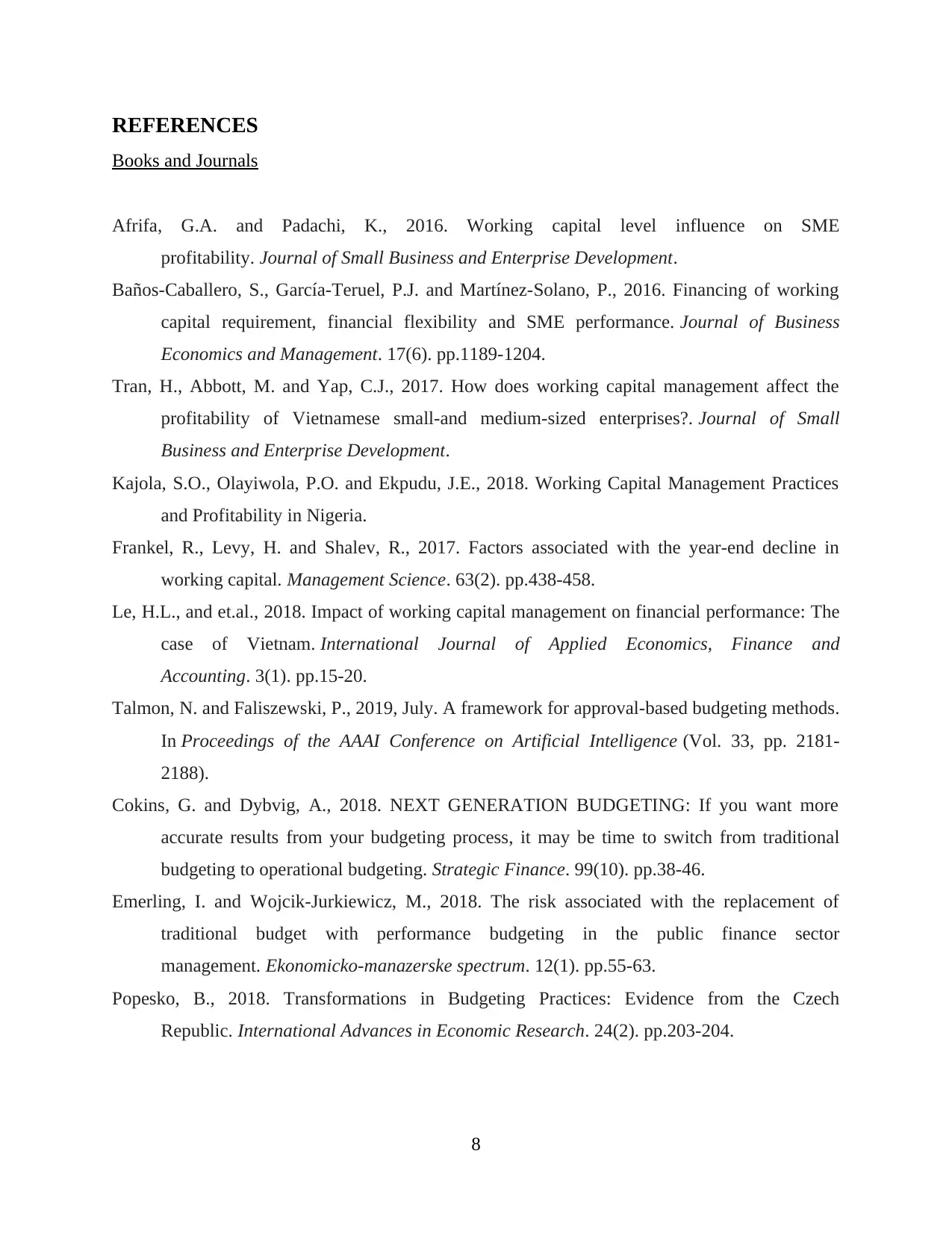
REFERENCES
Books and Journals
Afrifa, G.A. and Padachi, K., 2016. Working capital level influence on SME
profitability. Journal of Small Business and Enterprise Development.
Baños-Caballero, S., García-Teruel, P.J. and Martínez-Solano, P., 2016. Financing of working
capital requirement, financial flexibility and SME performance. Journal of Business
Economics and Management. 17(6). pp.1189-1204.
Tran, H., Abbott, M. and Yap, C.J., 2017. How does working capital management affect the
profitability of Vietnamese small-and medium-sized enterprises?. Journal of Small
Business and Enterprise Development.
Kajola, S.O., Olayiwola, P.O. and Ekpudu, J.E., 2018. Working Capital Management Practices
and Profitability in Nigeria.
Frankel, R., Levy, H. and Shalev, R., 2017. Factors associated with the year-end decline in
working capital. Management Science. 63(2). pp.438-458.
Le, H.L., and et.al., 2018. Impact of working capital management on financial performance: The
case of Vietnam. International Journal of Applied Economics, Finance and
Accounting. 3(1). pp.15-20.
Talmon, N. and Faliszewski, P., 2019, July. A framework for approval-based budgeting methods.
In Proceedings of the AAAI Conference on Artificial Intelligence (Vol. 33, pp. 2181-
2188).
Cokins, G. and Dybvig, A., 2018. NEXT GENERATION BUDGETING: If you want more
accurate results from your budgeting process, it may be time to switch from traditional
budgeting to operational budgeting. Strategic Finance. 99(10). pp.38-46.
Emerling, I. and Wojcik-Jurkiewicz, M., 2018. The risk associated with the replacement of
traditional budget with performance budgeting in the public finance sector
management. Ekonomicko-manazerske spectrum. 12(1). pp.55-63.
Popesko, B., 2018. Transformations in Budgeting Practices: Evidence from the Czech
Republic. International Advances in Economic Research. 24(2). pp.203-204.
8
Books and Journals
Afrifa, G.A. and Padachi, K., 2016. Working capital level influence on SME
profitability. Journal of Small Business and Enterprise Development.
Baños-Caballero, S., García-Teruel, P.J. and Martínez-Solano, P., 2016. Financing of working
capital requirement, financial flexibility and SME performance. Journal of Business
Economics and Management. 17(6). pp.1189-1204.
Tran, H., Abbott, M. and Yap, C.J., 2017. How does working capital management affect the
profitability of Vietnamese small-and medium-sized enterprises?. Journal of Small
Business and Enterprise Development.
Kajola, S.O., Olayiwola, P.O. and Ekpudu, J.E., 2018. Working Capital Management Practices
and Profitability in Nigeria.
Frankel, R., Levy, H. and Shalev, R., 2017. Factors associated with the year-end decline in
working capital. Management Science. 63(2). pp.438-458.
Le, H.L., and et.al., 2018. Impact of working capital management on financial performance: The
case of Vietnam. International Journal of Applied Economics, Finance and
Accounting. 3(1). pp.15-20.
Talmon, N. and Faliszewski, P., 2019, July. A framework for approval-based budgeting methods.
In Proceedings of the AAAI Conference on Artificial Intelligence (Vol. 33, pp. 2181-
2188).
Cokins, G. and Dybvig, A., 2018. NEXT GENERATION BUDGETING: If you want more
accurate results from your budgeting process, it may be time to switch from traditional
budgeting to operational budgeting. Strategic Finance. 99(10). pp.38-46.
Emerling, I. and Wojcik-Jurkiewicz, M., 2018. The risk associated with the replacement of
traditional budget with performance budgeting in the public finance sector
management. Ekonomicko-manazerske spectrum. 12(1). pp.55-63.
Popesko, B., 2018. Transformations in Budgeting Practices: Evidence from the Czech
Republic. International Advances in Economic Research. 24(2). pp.203-204.
8
Paraphrase This Document
Need a fresh take? Get an instant paraphrase of this document with our AI Paraphraser

9
1 out of 11
Related Documents
Your All-in-One AI-Powered Toolkit for Academic Success.
+13062052269
info@desklib.com
Available 24*7 on WhatsApp / Email
![[object Object]](/_next/static/media/star-bottom.7253800d.svg)
Unlock your academic potential
Copyright © 2020–2025 A2Z Services. All Rights Reserved. Developed and managed by ZUCOL.





